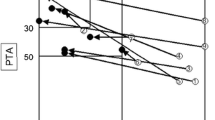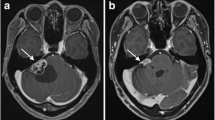Abstract
Background
In patients with a vestibular schwannoma, some studies have reported that useful hearing preserved initially after surgery deteriorates gradually in the long term. Studies with more patients are needed to clarify the maintenance rate of postoperative hearing function and to identify prognostic of hearing function.
Method
Ninety-one patients (mean age, 39.5 years; mean tumor size, 18.9 mm) with preserved useful hearing immediately after surgery were retrospectively analyzed. The useful hearing was defined as the American Academy of Otolaryngology-Head and Neck Surgery (AAO-HNS) classes A and B. Hearing tests, including auditory brainstem responses (ABR) and distortion product otoacoustic emissions (DPOAE), were evaluated preoperatively, immediately after surgery, and at outpatient follow-up.
Results
At the final follow-up (mean, 63.0 months), the useful hearing was maintained in 79 patients (87%), and the hearing class remained unchanged during the follow-up period in 40 patients (44%). Significant predictors of useful hearing maintenance were AAO-HNS class A immediately after surgery, improvement of ABR, and the absence of postoperative DPOAE deterioration. Postoperative DPOAE deterioration correlated with hearing class deterioration.
Conclusions
Despite hearing being preserved in vestibular schwannoma patients immediately after surgery, Thirteen percent lost their useful hearing during the long follow-up period, and hearing class worsened in 55% of the patients. This study, which analyzed one of the largest series of vestibular schwannoma patients, demonstrated that retrocochlear condition is a key factor for useful hearing maintenance. In patients with vestibular schwannoma who have preserved hearing function, regular postoperative monitoring of hearing function is as important as regular MRI.




Similar content being viewed by others
Abbreviations
- AAO-HNS:
-
American Academy of Otolaryngology-Head and Neck Surgery
- ABR:
-
Auditory brainstem responses
- DPOAE:
-
Distortion product otoacoustic emissions
- F/U:
-
Follow-up
- HB:
-
House–Brackmann
- iABR:
-
Improvement of ABR
- IPO:
-
Immediately postoperative
- N:
-
Normal detection
- ND:
-
Complete nondetection
- P:
-
Partial detection
- PDD:
-
Postoperative DPOAE deterioration
- PTA:
-
Pure tone average
- SEP:
-
Sensory evoked potentials
- SDS:
-
Speech discrimination score
References
Amano M, Kohno M, Nagata O, Taniguchi M, Sora S, Sato H (2011) Intraoperative continuous monitoring of evoked facial nerve electromyograms in acoustic neuroma surgery. Acta Neurochir (Wien) 153:1059–1067
Atlas MD, Harvey C, Fagan PA (1992) Hearing preservation in acoustic neuroma surgery: a continuing study. Laryngoscope 102:779–783
Baschnagel AM, Chen PY, Bojrab D, Pieper D, Kartush J, Didyuk O, Naumann IC, Maitz A, Grills IS (2013) Hearing preservation in patients with vestibular schwannoma treated with gamma knife surgery. J Neurosurg 118:571–578
Betchen SA, Walsh J, Post KD (2005) Long-term hearing preservation after surgery for vestibular schwannoma. J Neurosurg 102:6–9
Boari N, Bailo M, Gagliardi F, Franzin A, Gemma M, del Vecchio A, Bolognesi A, Picozzi P, Mortini P (2014) Gamma knife radiosurgery for vestibular schwannoma: clinical results at long-term follow-up in a series of 379 patients. J Neurosurg 121(Suppl):123–142
Carlson ML, Jacob JT, Pollock BE, Neff BA, Tombers NM, Driscoll CL, Link MJ (2013) Long-term hearing outcomes following stereotactic radiosurgery for vestibular schwannoma: patterns of hearing loss and variables influencing audiometric decline. J Neurosurg 118:579–587
Caye-Thomasen P, Dethloff T, Hansen S, Stangerup SE, Thomsen J (2007) Hearing in patients with intracanalicular vestibular schwannomas. Audiol Neurootol 12:1–12
Chee GH, Nedzelski JM, Rowed D (2003) Acoustic neuroma surgery: the results of long-term hearing preservation. Otol Neurotol 24:672–676
Friedman RA, Kesser B, Brackmann DE, Fisher LM, Slattery WH, Hitselberger WE (2003) Long-term hearing preservation after middle fossa removal of vestibular schwannoma. Otolaryngol Head Neck Surg 129:660–665
Hasegawa T, Kida Y, Kobayashi T, Yoshimoto M, Mori Y, Yoshida J (2005) Long-term outcomes in patients with vestibular schwannomas treated using gamma knife surgery: 10-year follow up. J Neurosurg 102:10–16
Hasegawa T, Kida Y, Kato T, Iizuka H, Yamamoto T (2011) Factors associated with hearing preservation after gamma knife surgery for vestibular schwannomas in patients who retain serviceable hearing. J Neurosurg 115:1078–1086
House JW, Brackmann DE (1985) Facial nerve grading system. Otolaryngol Head Neck Surg 93:146–147
Jacob JT, Carlson ML, Schiefer TK, Pollock BE, Driscoll CL, Link MJ (2014) Significance of cochlear dose in the radiosurgical treatment of vestibular schwannoma: controversies and unanswered questions. Neurosurgery 74:466–474 discussion 474
Kano H, Kondziolka D, Khan A, Flickinger JC, Lunsford LD (2009) Predictors of hearing preservation after stereotactic radiosurgery for acoustic neuroma. J Neurosurg 111:863–873
Kim YH, Kim DG, Han JH, Chung HT, Kim IK, Song SW, Park JH, Kim JW, Kim YH, Park CK, Kim CY, Paek SH, Jung HW (2013) Hearing outcomes after stereotactic radiosurgery for unilateral intracanalicular vestibular schwannomas: implication of transient volume expansion. Int J Radiat Oncol Biol Phys 85:61–67
Klijn S, Verheul JB, Beute GN, Leenstra S, Mulder JJ, Kunst HP, Hanssens PE (2016) Gamma Knife radiosurgery for vestibular schwannomas: evaluation of tumor control and its predictors in a large patient cohort in The Netherlands. J Neurosurg 124:1619–1626
Kohno M, Sora S, Sato H, Shinogami M, Yoneyama H (2015) Clinical features of vestibular schwannomas in patients who experience hearing improvement after surgery. Neurosurg Rev 38:331–341 discussion 341
Levo H, Blomstedt G, Pyykko I (2002) Is hearing preservation useful in vestibular schwannoma surgery? Ann Otol Rhinol Laryngol 111:392–396
Lin VY, Stewart C, Grebenyuk J, Tsao M, Rowed D, Chen J, Nedzelski J (2005) Unilateral acoustic neuromas: long-term hearing results in patients managed with fractionated stereotactic radiotherapy, hearing preservation surgery, and expectantly. Laryngoscope 115:292–296
Massager N, Nissim O, Delbrouck C, Delpierre I, Devriendt D, Desmedt F, Wikler D, Brotchi J, Levivier M (2007) Irradiation of cochlear structures during vestibular schwannoma radiosurgery and associated hearing outcome. J Neurosurg 107:733–739
Matsushima K, Kohno M, Nakajima N (2019) Hearing preservation in vestibular schwannoma surgery via retrosigmoid transmeatal approach. Acta Neurochir (Wien) 161:2265–2269
Mazzoni A, Zanoletti E, Calabrese V (2012) Hearing preservation surgery in acoustic neuroma: long-term results. Acta Otorhinolaryngol Ital 32:98–102
McKenna MJ, Halpin C, Ojemann RG, Nadol JB Jr, Montgomery WW, Levine RA, Carlisle E, Martuza R (1992) Long-term hearing results in patients after surgical removal of acoustic tumors with hearing preservation. Am J Otol 13:134–136
Mousavi SH, Kano H, Faraji AH, Gande A, Flickinger JC, Niranjan A, Monaco E 3rd, Lunsford LD (2015) Hearing preservation up to 3 years after gamma knife radiosurgery for Gardner-Robertson class I patients with vestibular Schwannomas. Neurosurgery 76:584–590 discussion 590-581
Mousavi SH, Niranjan A, Akpinar B, Huang M, Kano H, Tonetti D, Flickinger JC (2016) Dade Lunsford L (2016) Hearing subclassification may predict long-term auditory outcomes after radiosurgery for vestibular schwannoma patients with good hearing. J Neurosurg 125:845–852
Nakamizo A, Mori M, Inoue D, Amano T, Mizoguchi M, Yoshimoto K, Sasaki T (2013) Long-term hearing outcome after retrosigmoid removal of vestibular schwannoma. Neurol Med Chir (Tokyo) 53:688–694
Pennings RJ, Morris DP, Clarke L, Allen S, Walling S, Bance ML (2011) Natural history of hearing deterioration in intracanalicular vestibular schwannoma. Neurosurgery 68:68–77
Quist TS, Givens DJ, Gurgel RK, Chamoun R, Shelton C (2015) Hearing preservation after middle fossa vestibular schwannoma removal: are the results durable? Otolaryngol Head Neck Surg 152:706–711
Regis J, Carron R, Park MC, Soumare O, Delsanti C, Thomassin JM, Roche PH (2010) Wait-and-see strategy compared with proactive gamma knife surgery in patients with intracanalicular vestibular schwannomas. J Neurosurg 113(Suppl):105–111
Scheller C, Wienke A, Tatagiba M, Gharabaghi A, Ramina KF, Ganslandt O, Bischoff B, Matthies C, Westermaier T, Antoniadis G, Pedro MT, Rohde V, von Eckardstein K, Kretschmer T, Zenk J, Strauss C (2016) Stability of hearing preservation and regeneration capacity of the cochlear nerve following vestibular schwannoma surgery via a retrosigmoid approach. J Neurosurg 125:1277–1282
Shelton C, Hitselberger WE, House WF, Brackmann DE (1990) Hearing preservation after acoustic tumor removal: long-term results. Laryngoscope 100:115–119
Tucci DL, Telian SA, Kileny PR, Hoff JT, Kemink JL (1994) Stability of hearing preservation following acoustic neuroma surgery. Am J Otol 15:183–188
van Linge A, Borsboom GJ, Wieringa MH, Goedegebure A (2016) Hearing loss progresses faster in patients with growing intracanalicular vestibular schwannomas. Otol Neurotol 37:1442–1448
Watanabe S, Yamamoto M, Kawabe T, Koiso T, Yamamoto T, Matsumura A, Kasuya H (2016) Stereotactic radiosurgery for vestibular schwannomas: average 10-year follow-up results focusing on long-term hearing preservation. J Neurosurg 125:64–72
Woodson EA, Dempewolf RD, Gubbels SP, Porter AT, Oleson JJ, Hansen MR, Gantz BJ (2010) Long-term hearing preservation after microsurgical excision of vestibular schwannoma. Otol Neurotol 31:1144–1152
Yamakami I, Ito S, Higuchi Y (2014) Retrosigmoid removal of small acoustic neuroma: curative tumor removal with preservation of function. J Neurosurg 121:554–563
Yomo S, Carron R, Thomassin JM, Roche PH, Regis J (2012) Longitudinal analysis of hearing before and after radiosurgery for vestibular schwannoma. J Neurosurg 117:877–885
Author information
Authors and Affiliations
Contributions
We would like to thank Dr. Hitoshi Izawa and Dr. Jiro Akimoto for their help and advice. The authors are indebted to Helena Akiko Popiel, Department of International Medical Communications of Tokyo Medical University, for her review of the English manuscript. And, we thank Mrs. Asa Otonari for her assistance in preparing this manuscript.
Corresponding author
Ethics declarations
Conflict of interest
The authors declare that they have no conflict of interest.
Ethical approval
All procedures performed in studies involving human participants were in accordance with the ethical standards of the institutional and/or national research committee (Tokyo Medical University and Tokyo Metropolitan Police Hospital) and with the 1964 Helsinki declaration and its later amendments or comparable ethical standards.
Informed consent
For this type of study, formal consent is not required.
Additional information
Publisher’s note
Springer Nature remains neutral with regard to jurisdictional claims in published maps and institutional affiliations.
This article is part of the Topical Collection on Tumor - Schwannoma
Rights and permissions
About this article
Cite this article
Ichimasu, N., Kohno, M., Nakajima, N. et al. Long-term prognosis of preserved useful hearing after surgery in patients with vestibular schwannoma: a study of 91 cases. Acta Neurochir 162, 2619–2628 (2020). https://doi.org/10.1007/s00701-020-04523-2
Received:
Accepted:
Published:
Issue Date:
DOI: https://doi.org/10.1007/s00701-020-04523-2




